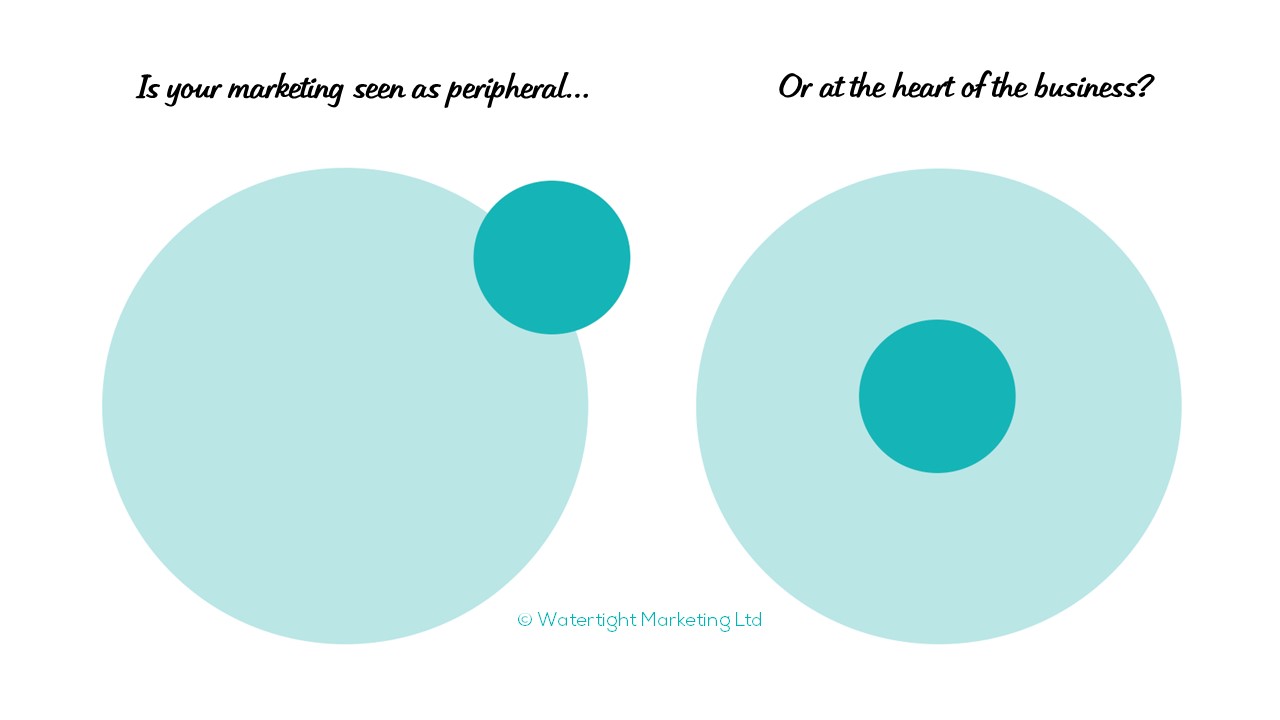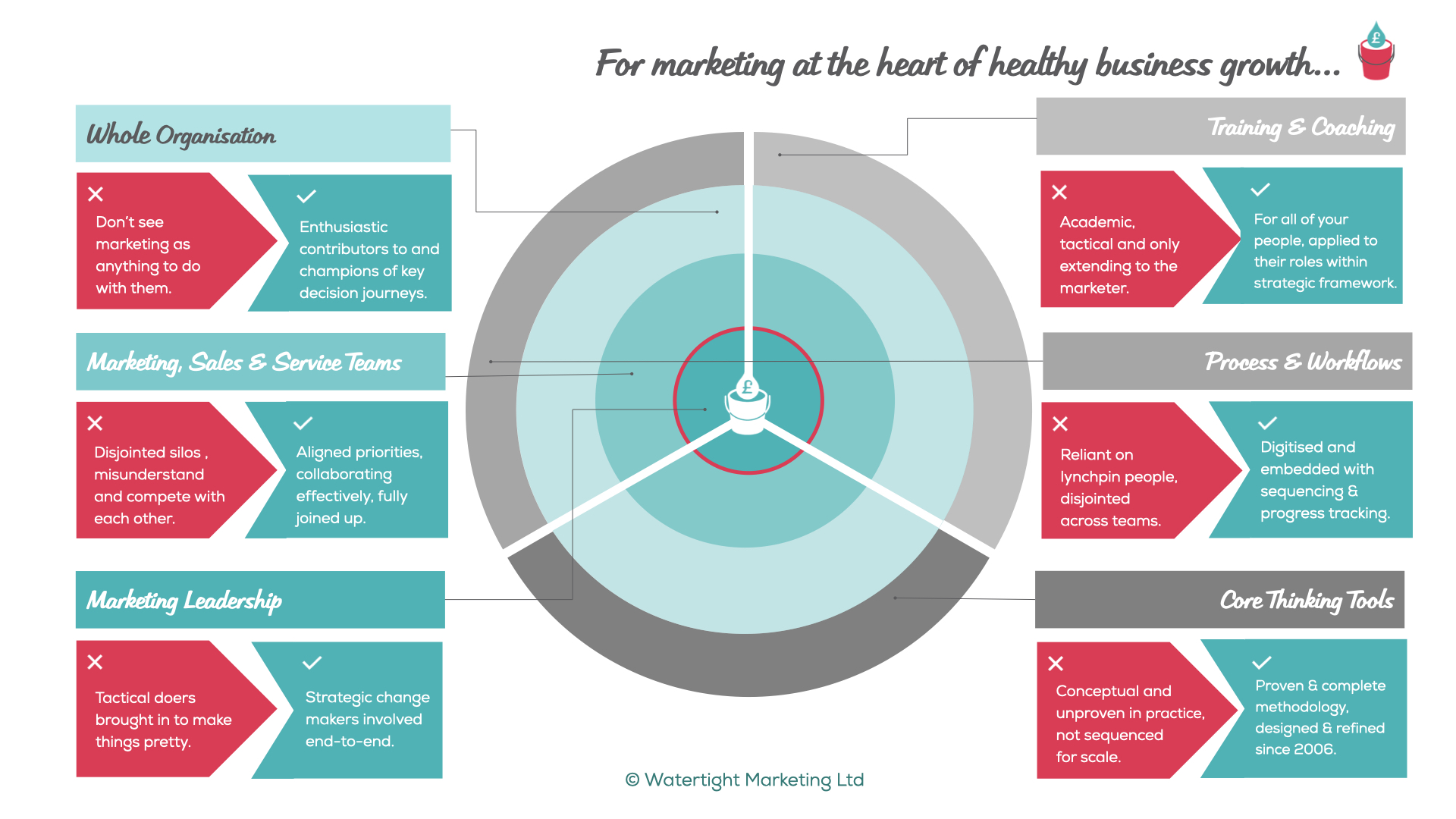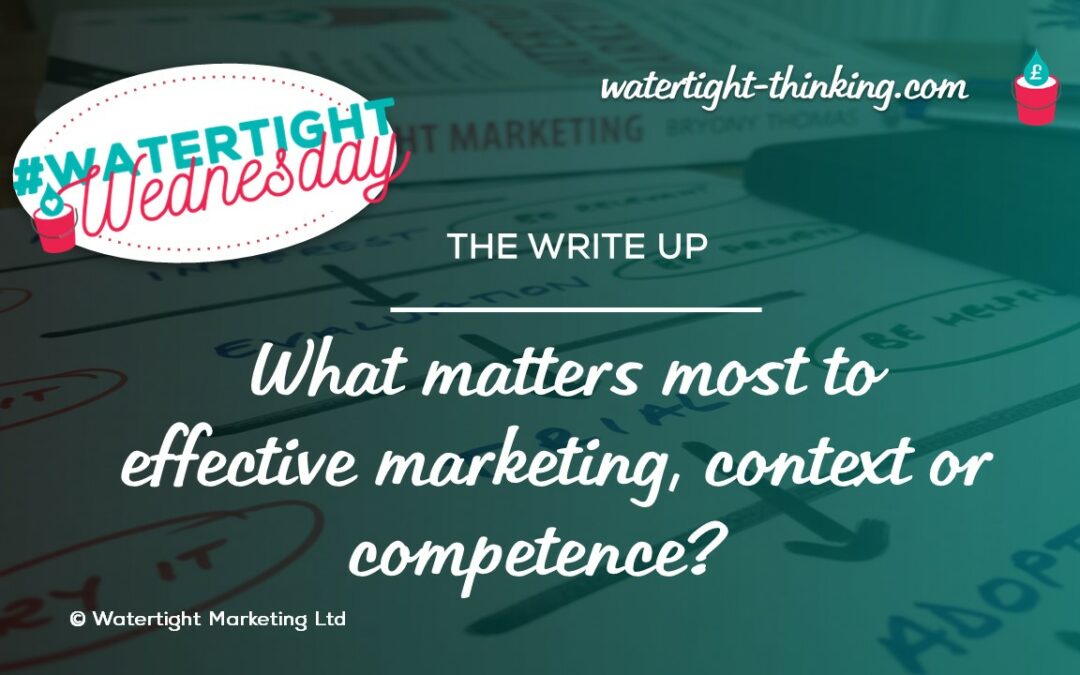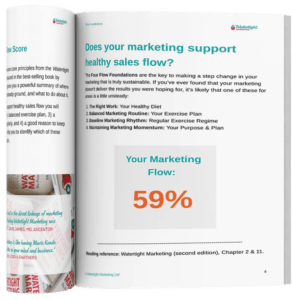Reading Time: 10 Minutes
“Competence of course is a key factor in determining how effective your marketing is. It’s a combination of experience, knowledge and skills. However, a marketer is unlikely to thrive and be truly effective, however good they are, if the business doesn’t provide the right context. That is: a clear vision and plan, active support, a voice at Board level and a common understanding of what marketing is and isn’t.” ~ Rachael Wheatley, Managing Director | Watertight Business Thinking
Listen to the session podcast here
60-minute roundtable discussion on what matters most to effective marketing, context or competence?
Bryony Thomas kicked off the discussion with some scene-setting. In the £2-50m businesses we tend to work with, what we often find is a frustration with marketing. That can be with the marketer themselves as well the impact marketing is having. When we look under the hood, we find that frustration can stem from a number of things:
- They’ve had a few ‘bounces’ with marketers who haven’t quite worked;
- They’ve gone through some agencies;
- They gone through some consultants.
We also look at the other ingredients which prevent marketing from being as effective as any business would want it to be.
What we see in many organisations is marketing as a peripheral activity, reacting to requests, rather than central to the organisation, at the heart of strategy, decision-making and thinking.

“Effective marketing is as much a matter of context as it is competence.” (Rachael Wheatley)
Marketing sits in the middle of a wider context. If we think about the different layers of marketing in an organisation, first we have the marketing leadership. Often brought in as tactical doers, what we’re looking for is for those people to be strategic change-makers. Then we have the marketing, sales and service teams supporting the whole customer journey. Often working in silos, they can misunderstand, or even compete with, one another. And then there’s everyone else who don’t necessarily see marketing as anything to do with them. But for marketing to be effective, what we need is enthusiastic contributors and champions of key decision journeys – whether that’s for customers, employees or suppliers.
What we want marketing to achieve is to:
- Lock in the success you’ve worked hard for
- Release lynchpin individuals from the day to day
- Turning instinct, what’s done naturally, into a repeatable and scalable process.
The ingredients that make this possible
There are three:
- Training and coaching: not academic and only for the marketers, but for all your people and applied to everyone’s roles within a strategic framework.
- Process and workflows: things like CRM, sign-off process, hand offs to sales, feedback from customer services into ideas for marketing. What the marketer needs is for these to be part of the way that people naturally work.
- Core thinking tools: there are many ways of organising thoughts and lots of thinking tools around. Often these are conceptual rather than proven and applied.
These ingredients come together to form an organisational marketing capability.

The competence of the marketer is in the middle – a small part of the wider mix. We believe the outer circle is what the business needs to work on, led by the MD and leadership team, including the lead marketer, creating a context that’s nourishing to enable marketing to thrive and allow people to do their best work.
What is competence in marketing all about?
Rachael Wheatley started the discussion by quickly looking at people’s perceptions. “Competence can be viewed as lacking when that’s actually not true – it can depend on what people see marketing as. It can also be hidden if the business is successful or laid bare if it’s struggling. And, the resources and tools you have (internal or external) may not be the right ones matched to what you need, thus creating a perception that marketing isn’t competent. This can make competence seem more important than context when actually that’s not necessarily the reason marketing isn’t working.”
“There’s also the competence in what people define as marketing – being able to put together a strategy or plan or manage a project. But there’s also other marketing competencies: wider business acumen, influencing people, communications skills, being persuasive, knowing your numbers, managing suppliers.” Bryony Thomas
“I believe that context feeds competence. If the context is there, you’re likely to employ someone good.” Cheryl Crichton
It certainly makes it more likely. However, “what can be a problem is if a business has never had an in-house marketing function and no-one who’s managed it before, so they don’t know what good looks like. It’s difficult to lead something you don’t have some level of skill in. The danger is then recruiting the wrong person.
And that marketing capability and competence needs to outlast an employee and reside in more than one person. “Part of the responsibility of a marketer who has a long-term view is to leave the function better than you found it and so that someone else can step in. That way, competence is embedded in the organisation.” Bryony Thomas
Context comes first
Maggie Mutkovicova has just left a firm where they were all generalists trying to be specialists and the context was missing. The marketing team and rest of the business were very disengaged and worked separately.
“There were a lot of competent people who picked things up quickly but once the good people left, they weren’t replaced, so all that work was wasted. I’m now in a job working for someone who actively encourages learning and development and doesn’t see competence as ever being ticked off.” Maggie Mutkovicova
Bryony Thomas responded: “That situation you describe could easily have led you to question your competence, and undermine your confidence, when actually the problem was systemic.”
“When the context is right it’s easier to recruit the right person and for them to do well. Obviously you need both – good context and competence – but if the context isn’t there, a new person coming in has to first try and create a good context and be very competent to do that. Conversely, if there’s a good context, the person coming in doesn’t necessarily need to be stand-out excellent.” Kristyna Kroblova
Watch out for the time lag: it can take time before marketing shows impact, often driven by the context in which it operates. “Where the context isn’t right, there’s a lag before marketing is seen to be effective because you’re first fixing the context – the invisible bits of marketing.” Bryony Thomas
Context or competence might need to change
“The wider organisation has to be up for that change. Otherwise it’s hard to thrive and it’s demotivating – and how long do you work like that?” Rachael Wheatley
“That needs to be assessed when you go through the door, to see whether you can deliver on what they’re expecting.” Bryony Thomas
Claire Thorpe has just left a strategic marketing role to set up her own business. “There’s a lot of context and competence in that decision because I battled with the context and eventually reached burn-out. For me it’s about the context within the competence – you can feel really competent but not have the right context; or the context can be great, but you don’t necessarily feel competent, yet, and might need a bit of coaching.” Claire Thorpe. In either case, something needs to change – context or competence or possibly both – for marketing to be effective.
“There’s courage in admitting there’s an underperformance in your area of responsibility but it is important to do that. Otherwise the context which is frustrating your ability is interpreted as incompetence. If you get ahead of it, you can manage it and ask for the support and resources you need.” Bryony Thomas
When you need the right knowledge and experience
Peter Baynes’ experience, via the Watertight-informed apprenticeship, shows that it can be a huge challenge for marketers.
“They may have competence but even if the context is right, leading marketing is always a hard job and you really need experience. So a younger, less qualified, less confident marketer is going to find it difficult. The first step should be to recruit a strategic marketer not a junior.” Peter Baynes
The other danger that Peter mentioned is when the manager doesn’t know enough about marketing to properly support a junior marketer – and so the right context isn’t created for them to feel competent.
“And sometimes a competent marketer comes into the business but they’re not doing the right things within the context – because they’re focusing on what they know, enjoy or what the MD thinks they need, without assessing whether these are relevant.” Peter Baynes.
Make competence visible through visuals
Kerry Turney: “I’ve been feeling a bit frustrated because it looks like I haven’t done anything. I’m building all these foundations and I know how much work I’ve done behind the scenes, but there’s not been much visible marketing.”
That’s where visual thinking tools can be really useful. “If you’ve got a framework that you have in common, then you can present and make visible your thinking and show all the work you’ve done.” Bryony Thomas.
“And including people in exercises and using the tools with them can help others to realise how competent you are and what’s involved in marketing.” Rachael Wheatley
“What we’ve done before is for different teams to share what a typical day is. When we did that for the marketing team, people said: I had no idea how much work went into creating a blog post.” Kristyna Kroblova
Lucy Morewood used a couple of the Watertight tools and bits of thinking in a new job to explain to the CEO what was going on and why marketing wasn’t effective. “It was really helpful to show them visually what the baseline marketing plan needed to be.”
There are many visual tools from Watertight Marketing you can see your thinking – the visual budgeting exercise (Chapter 9 of the book) is one example of how to get people to see how you’re spending money or time. If you give someone a spreadsheet, they’ll question the numbers. If you show them a chart, it invites a better, more productive strategic conversation.
Watertight Wisdom
What’s worked for us
Ideas from the group about how to shift the context in the organisation to be not just benign, but nourishing:
- Get everyone to read Watertight Marketing or at least to listen to the podblogs.
- Use Watertight in practice: use the tools, run sessions or ask questions to get them thinking.
- Take our marketing context test and chat through the results with people.
- Facilitate the conversation around vision, values, milestones and business strategy if that needs to be had so that the context can be shifted to one that supports marketing and where marketing can directly support business goals.
- The importance of getting in a room together – including the right people; it has a positive impact on how your competence is perceived, especially if it’s structured, using relevant tools and talking points.
- Ensure marketing leads context-setting – it puts marketing at the heart of the business, particularly if that session includes the whole team or business.
- Include the whole team – it helps to create a common language and understanding of marketing; after all everyone is working for the success of the business.
- Present visually, always contextualise the marketing you do and catch ideas from others – this encourages contributions from everyone and helps them to see where marketing fits in and what its effect is.
What would you add to our list? Do let us know your thoughts.
To join the conversation at our next Watertight Wednesday marketing roundtable you can sign up here. We’ll be having a chin-wag about creating seamless marketing, sales and service teams.

Rachael Wheatley
Managing Director, Watertight Thinking
Rachael brings over 30 years’ of marketing experience, with a particular focus on building and developing effective marketing teams that are able to act as a strategic driving force across an organisation. She has worked with Watertight since 2014 as a Master Practitioner and joined the business as MD in 2022.



